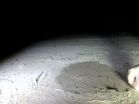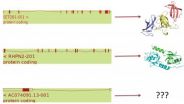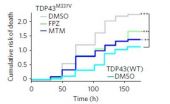(Press-News.org) There's more to trying to slow down climate change than just cutting greenhouse gas emissions. Technology, policies or plans that aim to do so should also take environmental factors such as water usage into account. A more integrated approach might make some options considerably more attractive than others, especially when implemented in arid countries such as Australia, advise Philip Wallis of Monash University in Australia and colleagues, in an article in Springer's journal Climatic Change.
The researchers considered the example of Australia to show how water usage influences the appeal of certain preferred mitigation options. They analyzed 74 options that were ranked in the influential "Low Carbon Growth Plan for Australia" in 2010, and together could help Australia cut its 2000 emission levels by 25 percent by 2020.
The options varied considerably as to how much water each one uses. Energy efficiency measures were found to reduce water consumption, as do measures in the power sector generally. Renewable options such as solar thermal power only moderately impact water consumption. Further reductions are possible by tapping into existing power-related water supplies or using air or salt-water cooling. Wind power, biogas, solar photovoltaics, energy efficiency and operational improvements to existing power sources can reduce water demand by offsetting the water used to cool thermal power generation. This could help save nearly 100 Mmᶾ of water in Australia annually by 2020. Wallis believes the technologies and locations used for renewable energy should appropriately reflect water constraints.
Land-based mitigation measures such as "carbon farming" for carbon credits and the suggested reforestation of land use the most water. This is likely to influence catchment water yields, depending on where planting takes place. Although such plantings can also help reduce salinity, erosion, and flooding, the researchers believe some of these endeavors should be reconsidered, either in the scale of plantings, their location, or the carbon price required for these to be cost effective.
The reconfiguring of Australian cities towards water-efficient and low-energy systems represents both a significant challenge and opportunity. Energy is a substantial operational cost in the water industry, especially since the increased use of inter-basin water transfers and desalination plants. Urban water management indirectly influences 13 percent of electricity use plus 18 percent of Australia's natural gas usage. The water supply and waste-water sectors can however ensure savings by moving towards higher energy efficiency by using, for example, variable-speed water pumps and smart water meters, and renewable energy options such as small-scale hydroelectric plants. Demand management programs targeting hot water and the diversion or localized treatment of different types of waste-water should also be considered.
"This integrated analysis significantly changes the attractiveness of some mitigation options, compared to cases where water impacts are not considered," believes Wallis. "This Australian case shows that mitigation measures that carry water co-benefits, especially energy efficiency, ought to be pursued."
INFORMATION:
Reference: Wallis, P.J. et al (2014). The water impacts of climate change mitigation measures, Climatic Change. DOI 10.1007/s10584-014-1156-6
The full-text article is available to journalists on request.
Consider water use in climate change policies, advise Australian researchers
Energy efficient technologies can also save water at the same time
2014-07-03
ELSE PRESS RELEASES FROM THIS DATE:
Jump to it! A frog's leaping style depends on the environment
2014-07-03
VIDEO:
Tree frogs reach great heights with their jumps, but do not cover much distance.
Click here for more information.
A frog's jump is not as simple as it seems....Australian scientists have discovered that different species adopt different jumping styles depending on their environment.
Lead researcher, Miss Marta Vidal-Garcia ( PhD candidate, Australian National University ), found that tree dwelling frogs reached great heights but didn't cover much distance with their ...
Study finds higher risk for celiac disease in some children
2014-07-03
AURORA, Colo. (July 3, 2014) – Physicians from the University of Colorado School of Medicine in collaboration with an international team of researchers have demonstrated that screening of genetically susceptible infants can lead to the diagnosis of celiac disease at a very early age.
The collaborative group studied 6,403 children with specific genetic markers from birth to identify the factors involved in the development of both celiac disease and type 1 diabetes. The children are from the United States, Finland, Germany and Sweden and are part of The Environmental Determinants ...
Biological signal processing: Body cells -- instrumentalists in a symphony orchestra
2014-07-03
Every organism has one aim: to survive. Its body cells all work in concert to keep it alive. They do so through finely tuned means of communication. Together with cooperation partners from Berlin and Cambridge, scientists at the Luxembourg Centre for Systems Biomedicine (LCSB) of the University of Luxembourg have now successfully revealed for the first time the laws by which cells translate signals from their surroundings into internal signals. Like an isolated note in a symphony orchestra, an isolated signal in the cell is of subordinate importance. "What is important ...
A CNIO team reduces the size of the human genome to 19,000 genes
2014-07-03
How nutrients are metabolised and how neurons communicate in the brain are just some of the messages coded by the 3 billion letters that make up the human genome. The detection and characterisation of the genes present in this mass of information is a complex task that has been a source of ongoing debate since the first systematic attempts by the Human Genome Project more than ten years ago.
A study led by Alfonso Valencia, Vice-Director of Basic Research at the Spanish National Cancer Research Centre (CNIO) and head of the Structural Computational Biology Group, and ...
Could boosting brain cells' appetites fight disease? New research shows promise
2014-07-03
ANN ARBOR, Mich. — Deep inside the brains of people with dementia and Lou Gehrig's disease, globs of abnormal protein gum up the inner workings of brain cells – dooming them to an early death.
But boosting those cells' natural ability to clean up those clogs might hold the key to better treatment for such conditions.
That's the key finding of new research from a University of Michigan Medical School physician scientist and his colleagues in California and the United Kingdom. They reported their latest findings this week in the journal Nature Chemical Biology.
Though ...
Ironing out details of the carbon cycle
2014-07-03
Iron is present in tiny concentrations in seawater. On the order of a few billionths of a gram in a liter.
"I did a calculation once on a ton of ocean water," says Seth John, an assistant professor in the department of marine science at the University of South Carolina. "The amount of iron in that ton of water would weigh about as much as a single eyelash."
Given that there is so little iron in seawater, one might conclude that its presence there is inconsequential.
Hardly. Iron is one of the essential elements of life. Found in enzymes like myoglobin and hemoglobin ...
Science Elements podcast highlights the science of fireworks
2014-07-03
The July feature of Science Elements, the American Chemical Society's (ACS') weekly podcast series, shines the spotlight on the science of fireworks, just in time for the July 4th holiday. The episode is available at http://www.acs.org/scienceelements.
Independence Day is a time for picnics, parades and, of course, fireworks. Those beautiful explosions in the sky would be nothing without chemistry. In today's episode, Science Elements talks to the man who literally wrote the book on fireworks.
"Everything you see in a fireworks display is chemistry in action," says ...
Decade of benefits for the Great Barrier Reef
2014-07-03
With this week marking the tenth anniversary of the rezoning of the Great Barrier Reef Marine Park, prominent marine scientists from around the world have gathered in Canberra to discuss its successes - both expected and unexpected.
"At the time, the rezoning of the Great Barrier Reef Marine Park was the largest marine conservation measure in the world," says Professor Garry Russ from the ARC Centre of Excellence for Coral Reef Studies (Coral CoE). "The Reef went from being five percent protected to about 30 percent. So now, a third of it is green, or no-take, zones."
Designed ...
Lessons from the west: Great Barrier Reef in danger
2014-07-03
Scientists at a coral reef symposium in Canberra this week are examining degraded reefs off the Northwest Australian coast in an effort to determine what lies ahead for the Great Barrier Reef.
"Reefs north of Exmouth have experienced large-scale bleaching in the past five years," says Professor Malcolm McCulloch from the ARC Centre of Excellence for Coral Reef Studies (Coral CoE) at the University of Western Australia.
McCulloch is in the midst of an autopsy of this Pilbara bleaching event, collecting and analysing both living and dead stony coral. He says the bleaching ...
Forecasting the development of breakthrough technologies to enable novel space missions
2014-07-03
A new report, Technological Breakthroughs for Scientific Progress (TECHBREAK), has been published today by the European Science Foundation.
The European Science Foundation (ESF) was contacted at the end of 2009 to conduct a foresight activity for the European Space Agency (ESA), addressing the matter of technological breakthroughs for space originating in the non-space sector. A "Forward Look" project jointly funded by ESA and ESF and called 'TECHBREAK' was initiated as a result. Its goals were to forecast the development of such breakthrough technologies to enable novel ...
LAST 30 PRESS RELEASES:
Structure of dopamine-releasing neurons relates to the type of circuits they form for smell-processing
Reducing social isolation protects the brain in later life
Keeping the heart healthy increases longevity even after cancer
Young adults commonly mix cannabis with nicotine and tobacco
Comprehensive review illuminates tau protein's dual nature in brain health, disease, and emerging psychiatric connections
Book prepares K-12 leaders for the next public health crisis
Storms in the Southern Ocean mitigates global warming
Seals on the move: Research reveals key data for offshore development and international ecology
Sports injuries sustained during your period might be more severe
World's first successful 2 Tbit/s free-space optical communication using small optical terminals mountable on satellites and HAPS
Can intimate relationships affect your heart? New study says ‘yes’
Scalable and healable gradient textiles for multi‑scenario radiative cooling via bicomponent blow spinning
Research shows informed traders never let a good climate crisis go to waste
Intelligent XGBoost framework enhances asphalt pavement skid resistance assessment
Dual-function biomaterials for postoperative osteosarcoma: Tumor suppression and bone regeneration
New framework reveals where transport emissions concentrate in Singapore
NTP-enhanced lattice oxygen activation in Ce-Co catalysts for low-temperature soot combustion
Synergistic interface engineering in Cu-Zn-Ce catalysts for efficient CO2 hydrogenation to methanol
COVID-19 leaves a lasting mark on the human brain
Scientists use ultrasound to soften and treat cancer tumors without damaging healthy tissue
Community swimming program for Black youth boosts skills, sense of belonging, study finds
Specific depressive symptoms in midlife linked to increased dementia risk
An ‘illuminating’ design sheds light on cholesterol
Who is more likely to get long COVID?
Study showcases resilience and rapid growth of “living rocks”
Naval Research Lab diver earns Office of Naval Research 2025 Sailor of the Year
New Mayo-led study establishes practical definition for rapidly progressive dementia
Fossil fuel industry’s “climate false solutions” reinforce its power and aggravate environmental injustice
Researchers reveal bias in a widely used measure of algorithm performance
Alcohol causes cancer. A study from IOCB Prague confirms damage to DNA and shows how cells defend against it
[Press-News.org] Consider water use in climate change policies, advise Australian researchersEnergy efficient technologies can also save water at the same time



